Steamer600 is a projection system that appears on Fangraphs (for free) around Thanksgiving. Steamer600 is unique in that it does not attempt to foretell playing time. Instead, each hitter is given 600 plate appearances, each starting pitcher is given 200 innings pitched, and each relief pitcher is given 65 innings pitched. It is a measure of talent that overlooks lost time due to injury, suspension, lack of a regular role, and/or players waiting for a call-up from the minor leagues.
Steamer600 is an interesting projections system to use in offseason research because it can identify players who could take a step forward with an increase in playing time. For example, Justin Turner, Corey Seager, Carlos Correa, and Yasmani Grandal stand out as surprising WAR leaders. The obvious problem for these players is that they haven’t been anywhere near 600 plate appearances in the last few years, and therefore have a much lower value in fantasy. As a side note, Steamer600 gives catchers an at-bat projection of 450 (75%) because of the nature of their demanding job behind the plate, and the expected days-off.
The main shortcoming of Steamer600 is obvious: We know that a large number of players aren’t going to get 600 plate appearances and assuming that they will is foolhardy.
Starting pitchers are all given 200 innings pitched, but there is no way that Rich Hill, Michael Pineda, Zac Gallen, Julio Urias, and Justus Sheffield will throw 200 innings in a full-schedule 2020.
What happens, though, in a shortened season? If baseball resumes and the MLB season is 135, 120, 100, or 81 games (for example), no one is going to get 600 plate appearances or throw 200 innings.
What is fascinating about a shortened season is that Steamer600 instantly becomes much more realistic because the lofty 200-inning assumption must be dialed down and the new target becomes much more attainable. That means that Steamer600’s biggest shortcoming is overcome, and Steamer600 pitcher projections could be much more realistic.
I have created a Google Sheet here that modifies Steamer600’s numbers. On the “Steamer600 Pitchers” tab, simply enter the number of innings that you project in Cell B1 (in bold, and in green) and all Steamer600 projected statistics will adjust to your selected number of innings. This will automatically adjust innings pitched for relievers in the same ratio and will change their statistics accordingly. To manipulate the sheet, click “Make a Copy” in the File menu.
There is an obvious problem/question: Do we really expect a relief pitcher’s innings to decrease in the same ratio as a starter’s? If, for example, we reduce all the starters’ games from 32 (200 innings) down to 16 (100 innings), should we reduce a relief pitcher’s IP from 65 down to 32.5? Probably not. I would expect relief pitchers to pitch fewer innings, but in a half-season (as per this example), I still see relievers throwing a larger percentage of innings. I have decided that it probably isn’t worth the hassle to adjust the innings pitched for relievers but to just leave them at the same 200:65 ratio. This gets the point across and fiddling with the numbers doesn’t really help us to identify any interesting relievers, since we won’t know how teams will deploy relievers in a modified season.
The numbers in this spreadsheet are created simply by ratcheting down all the Steamer600 by the same ratio. Looking at the Steamer600 results will garner the same results, but adjusting the inning is simply a way to simplify matters. What is salient is that Steamer600’s use of 200 IP per pitcher is unrealistic in real life, but a shortened season could realistically see many more pitchers reach a 120-inning or 150-inning mark. We can, therefore, see the value of Steamer600 and the skills-based results it creates.
There are two noticeable problems with the Steamer600 ranks. One, it has not been updated to remove players who are injured. Chris Sale, Luis Severino, and Noah Syndergaard appear frequently, but must be ignored because they will not pitch in any form of a 2020 season. I have left them in since Steamer600 equates all starters to 200 innings regardless of the reasons why they may or may not reach that threshold.
The second problem is that Steamer600 makes a lot of errors classifying pitchers. A lot of pitchers who we expect will start the season in their team’s rotation are classified as relievers (Jesus Luzardo, Kenta Maeda, Carlos Martinez, etc.) These pitchers are considered relief pitchers and are given 65 innings pitched. Because of this, I created a second tab, “SPARPs” and have taken their (updated) Steamer projections (red columns) and have bumped them up to 200 innings (teal columns) and have made it possible to adjust these numbers to a custom amount of innings pitched in Cell B1 (bold, green). The results for the custom amount are presented in the blue columns.
The numbers presented in the SPARPs tab should be considered with the appropriate grain of salt due to the fact that they are not coming directly from Steamer600 and their efficacy may have been lost in translation. Still, the numbers generated seem reasonable and are worth considering.
WAR
The players are ranked according to WAR. If we assume 200 IP for every player, we very quickly see some fascinating results:
- Aces gonna ace: The top pitchers are the usual suspects: Gerrit Cole, Jacob deGrom, Max Scherzer, Justin Verlander. We know that in 200 innings, these studs are going to be some of the best in baseball. They usually exceed 200 innings and put up the best numbers. We expect them to be at the top of the list even if others rise.
- Accumulators fall: Pitchers who throw more than 200 IP in a season are very valuable in fantasy because they accumulate counting stats and these stats contribute to our teams. Pitchers who benefit from these large innings-counts are not nearly as valuable in a hypothetical world where every pitcher throws equal innings. In fantasy, pitchers like Mike Leake, Marco Gonzalez, and Mike Fiers throw a lot of innings in a season, but they don’t have the skills to get our fantasy teams a lot of strikeouts, wins, or elite ratios; their contributions are their volume of innings. They can get 150 strikeouts in a season with a 6.5 K/9 because they throw enough innings to do so. There is value in accumulators in a normal fantasy season, but that value is reduced in a shortened season as durability becomes less of a concern.
- High-skills, low-innings pitchers rise: No surprise here. Pitchers who never throw 200 innings because of injury, workload restrictions, or inconsistency role get a huge boost. We know that Rich Hill, Lance McCullers, Hyun-Jin Ryu, and James Paxton have excellent stuff and, when they pitch, they put up excellent results. The problem is that something usually reduces their number of starts. If we can turn injuries off, these pitchers rise dramatically, and Steamer600 shows that.
Strikeouts
Strikeouts become a who’s who of K/9 leaders. When innings pitched are equal for all starting pitchers, the criteria of evaluation, logically, becomes projected K/9. Here are the top 30 Steamer600 projected strikeout leaders:
Again, aces gonna ace, but some names jump out: Dinelson Lamet, Tyler Glasnow, Shohei Ohtani, Robbie Ray, Michael Kopech, Carlos Carrasco, and Lance McCullers Jr. These names stand out, but are not surprising—all have missed time due to injury or inconsistency and many have been refining their pitch arsenal and developing their skills.
Dinelson Lamet: Lamet debuted in 2017 and threw 114.1 innings with a 10.94 K/9. He missed all of 2018 and most of 2019 recovering from Tommy John Surgery, but put up a 12.95 K/9 in 73 innings upon his return last season. Steamer600 gives him an 11.43 K/9 in 2020 which would vault him into fifth on the leaderboard if he threw 200 innings. Though he did pitch well in 2019, there isn’t much chance that he would get near 200 innings in a full 2020 with TJS within sight in the rear-view mirror. In a shortened 2020, he could be much more likely to pitch a full schedule. If the season is shortened to 81 games, Lamet could very easily toss the same 100 innings as other pitchers and his projected K/9 could put him near the top of strikeout leaderboards.
Tyler Glasnow: The model of inconsistency. Glasnow’s maximum innings pitched in a season is 111.2 in 2018. He was spectacular in 2019 putting up a 1.78 ERA, 2.26 FIP, 0.89 WHIP, with a 33 K% and a paltry 6.1 BB%. The problem was that these results came in just 60.2 innings. Glasnow pitched in eight games before a forearm and wrist injury sent him to the IL until September. His 11.27 K/9 in his abbreviated season explains why Steamer600 gives him a projected 11.26 K/9 and we see why Steamer600 projects him as the eighth SP in strikeouts. As fantasy managers, we can dream about Glasnow’s production if he gets 200 innings, but it is far-fetched to believe he could get anywhere near that number in a full 2020. In a 100-inning season, if he can remain healthy, top-of-the-league strikeout production is plausible.
Shohei Ohtani: Ohtani is a baseball fan’s dream and a fantasy manager’s nightmare. It’s hard not to love a player who appears near the top of Steamer600’s hitting and pitching leaderboards. Ohtani would easily be the number one overall fantasy player if he threw 200 innings and had 600 plate appearances, and it wouldn’t even be close. We know that that is impossible. The only way that Ohtani pitches 200 innings is if he foregoes being a two-way player and instead focuses only on pitching. With his skills, it would be equally understandable that he becomes an everyday hitter and gets 600 plate appearances. Ohtani is a complete mess to figure out in a shortened season, because we don’t yet know the schedule and how he might be used in a week if there are between six and eight (or maybe even more?) games per week.
Robbie Ray: We know that Robbie Ray gets strikeouts. We also know that those strikeouts come at the expense of innings pitched. From 2016-2019, Ray made 117 starts but never exceeded 174.1 innings thanks, in part, to his maddeningly low Innings Pitched per Start. His career 1.35 WHIP is high and Ray has never been a pitcher who efficiently runs through the order. Still, his K% over those seasons has ranged from 28.1% to 32.8% and his K/9 has been 11.25, 12.11, 12.01 and 12.13, respectively. Clearly, Steamer600 looks fondly on Ray in 200 innings, and he should benefit in strikeouts in any modification to the 2020 season, at least when it comes to strikeouts.
Michael Kopech: Steamer600 loves Kopech. After missing 2019 recovering from TJS, Kopech is projected to have a 10.36 K/9 which is more in line with his production in the Minors than his results in his four starts 2018. In High-A, Kopech had a 14.19 K/9, an 11.69 in Double-A, and a 12.11 in Triple-A, before his call-up. It was unclear if Kopech was going to be ready for a full season as a starter, but a delay should give him more time to recover. While 200 innings would have been out of the question, a shortened season should help Kopech. If he has recovered from his TJS, he should be able to grab some strikeouts, and if he can get near his projected K/9, he could be a valuable piece late in drafts.
Carlos Carrasco: It was nice to see Cookie back at the end of 2019. He has thrown 200 innings in the past (200 in 2017, and 192 in 2018) and, after battling Leukemia, it’s easy to look past his 5.29 ERA and 80 innings pitched in 2019. Still, his K/9 was 10.80 last season which was the highest of his career. A projected 9.88 seems reasonable if he has the energy and stamina to throw a full shortened season. He is especially interesting because returning to 200 innings appeared a low-probability bet, but 120, or so, innings after a few extra months of rest and fitness training is much more likely.
SPARPs: We shouldn’t forget about the pitchers that are not included in the above list because Steamer600 regards them as relievers instead of starters. Steamer gives Freddy Peralta an 11.27 K/9, Josh James an 11.19 K/9, A.J. Puk a 9.97 K/9, Nick Pivetta a 9.90 K/9, Vince Velasquez a 9.91 and Brendan McKay a 9.95 K/9. All these pitchers would have appeared on the above leaderboard if Steamer600 swapped their 65 relief innings with the 200 IP for starters. It is prudent to take these suggestions with some skepticism because we can expect that their K/9 will not be as robust in a starting role as it may have been as a part of their team’s bullpen. Still, a shortened season may really benefit these pitchers.
Others to Consider: Andrew Heaney, Chris Archer, Mitch Keller, Dylan Cease, Rich Hill, German Marquez, Max Fried, Eduardo Rodriguez, Spencer Howard, Drew Smyly, Jon Gray, Corbin Burnes.
Wins
The pitchers who top the wins list are the top-tier aces and pitchers who are on great teams. Aces are the best in the game because they can rise above any shortcomings of their team, but in an evened-innings projection, the lower-tier pitchers get a boost from their team context because projection systems project their teams to get more wins.
Lance McCullers Jr.: I didn’t expand on McCullers in the strikeouts section because I knew that I would mention him here. Despite their ethical deficiencies, the Astros are still a good team. McCullers is back after TJS and even though he may think that he shouldn’t be on an innings restriction, it’s clear that the Astros were not planning on him getting anywhere near 200 innings. Injuries have been a problem throughout his career and his max innings per season was 128.1 in 2018, before his TJS. In that season, he had a 9.96 K/9, down from 10.01 in 2017 and 11.78 in 2016. McCullers can get strikeouts and his skills show that he can be a great strikeout pitcher if he could put up an ace’s volume. McCullers was set to enter the season as a part of the Astros’ rotation and the shortened season brings all the other high-volume pitchers back to him. Houston’s management ballparked a 120-innings limit for McCullers in 2020, so if every pitcher throws around 120 innings, McCullers’ spot on the pitching leaderboards could look a lot like Steamer600’s projections.
David Price: It is still hard to wrap my head around the fact that David Price is a Dodger. In his 12-year career, Price has thrown over 200 innings six times and more than 175 innings eight times. Injuries have slowed him in recent years, but Price has shown himself as a top pitcher and is ace-like when he pitches. The move to LA makes the Dodgers a clear favorite in the NL (if they weren’t already, even before acquiring both Price and Mookie Betts!) and projections see Price benefiting from the move to the NL West. Even if he doesn’t pitch at his best, the Dodgers should still plate a ton of runs and Price will benefit in wins.
James Paxton and Rich Hill: Both Paxton and Hill are recovering from injury and were set to miss the first few months of the season. Even if they both had perfect health to start the season, there was still just a small chance that either would toss 200 innings. Since his 195 IP in 2007, Hill has never exceeded 136 innings, and Paxton’s max is 160.1 IP (in 2018). Steamer600 assumes 32 starts and both pitchers show, on a level playing field, that they could be among the leaders in wins thanks to their juggernaut teams. If Hill and Paxton can both throw 100 innings, we know that they will be quality and with the rest of the league’s pitchers throttled back, both Paxton and Hill become a lot more interesting.
Nathan Eovaldi: The name that really stands out on this list is Eovaldi. After just 67.2 innings in 2019, Steamer600 projections have Eovaldi with 14 wins. There are two things to consider here before getting too excited. One, despite Eovaldi’s win projection, Steamer600 has him with a 4.24 ERA, and the projected 1.30 WHIP is the highest of all pitchers on the Wins Leaderboard. The second consideration is the team context. The results have David Price as a Dodger, but we don’t know if Eovaldi’s projected wins total considers Mookie Betts on the Boston roster. Still, Steamer has Eovaldi with 10 wins on the season in 143 IP, so if that is ratcheted up to 200, 14 does seem possible. Though he has struggled with injuries lately, in a shortened season, it might pay to remember Eovaldi, especially considering his listed ADP of 441.8. At about a strikeout per inning, pairing him with a low ERA ace or a stud reliever could mitigate his ERA and WHIP deficiencies.
Jack Flaherty: In his first full season (2018) with the Cardinals, Flaherty threw 151 innings and last year tossed 196.1 in 61 starts over the two seasons. He is one of those pitchers that dinged by the Steamer600 IP-limiter. Steamer has him at 192 IP, putting his projection as the 17th most in baseball (deGrom is highest at 205 IP). Flaherty also is hurt by his team. While his projected 3.59 ERA and 1.17 WHIP are excellent, Steamer600 doesn’t believe that the Cardinals’ bats will support him for wins. In a full season, Flaherty’s expected innings volume earns him a lot of accumulated stats, but in a shortened season, he just won’t be able to use his health and stamina to distance himself from the field.
Jose Urquidy: Like McCullers, Urquidy should benefit from his team context. Steamer projects Urquidy to throw 149 innings with 10 wins, a 4.45 ERA, 1.24 WHIP and an 8.91 K/9. These numbers are good, but not spectacular. Steamer600 will value pitchers on good teams, and Urquidy gets a boost when his innings are bumped to 200. At a post-200 ADP, a shortened season helps Urquidy, but also benefits all the pitchers who are on top teams. Considering the third and fourth starters on any of the expected divisional winners is a good place to start.
Andrew Heaney: We shouldn’t forget about the improvements the Angels made in the off-season. Adding Anthony Rendon, Jason Castro, and the healthy return of Shohei Ohtani, Justin Upton, and Tommy LaStella should benefit all their pitchers. Heaney threw 180 innings in 2018 to a 4.15 ERA and 1.20 WHIP with a strikeout per inning. Injuries derailed his 2019, but with a 180-inning season on his ledger, there is hope that he can be healthy enough to pitch an entire shortened season and could be a Wins contributor.
Julio Urias, Kenta Maeda, Alex Wood, and Jesus Luzardo: These are Steamer600 relief pitchers who are set to be starters in 2020. In my rudimentary translation of their Steamer projections into 200 innings pitched, each pitcher is expected to benefit from the strength of their team and, as starters, they should be in a position to get a lot of wins. Steamer’s IP projections for all the pitchers in the group are all under 163 and so even the most optimistic managers couldn’t expect any of them to reach 200 innings. The shortened season should make all these pitchers contributors in Wins.
Others to Consider: Frankie Montas, Mike Soroka, Jake Odorizzi, Martin Perez, Dylan Bundy, Patrick Sandoval, Mitch Keller, Hyun-Jin Ryu, Anthony DeSclafani, Dylan Cease, Adrian Houser, Ross Stripling, Dustin May.
ERA and WHIP
As a ratio statistic, ERA and WHIP will not be impacted to the same degree as the counting categories when adjusted to different innings-pitched limits. If a pitcher throws a 3.50 ERA in 150 innings, we can expect him to throw a 3.50 ERA in 200 innings. Sure, we could see a pitcher get on a run like Jack Flaherty and Yu Darvish did to end 2019, but, for the most part, ERA and WHIP should not be impacted too much. Projections are season-long and a potential hot/cold streak even themselves out. Steamer600’s numbers for ERA and WHIP are the same as their results for their Steamer projections.
Therefore, Steamer600’s ratio stats leaders are an expected list of stellar starters and the top-tier pitchers. There are a few names that emerge in ERA:
Tyler Glasnow, David Price, Shohei Ohtani, Dinelson Lamet, Lance McCullers Jr. and Andrew Heaney have all been discussed earlier. These are pitchers whose skills Steamer600 likes and, as a result, they are projected to have top-end ERA results.
Marcus Stroman: As a relatively durable pitcher, Stroman made 32 (or more) starts in three of his last four seasons. In 2019, he tossed a 3.22 ERA. Wait, what?! Marcus Stroman had a 3.22 ERA in 2019? The 2019 with a low-drag ball that saw all-time home run records fall on an almost daily basis? Stroman had a 53.7 GB% and a 12.6 HR/FB%. As a pitcher who gets ground balls, Stroman is an ERA helper late in drafts. He 7.36 career K/9 isn’t impressive, but Stroman is able to keep the ball in the yard and will stabilize the ERA category.
Garrett Richards: Poor Garrett Richards. So much potential, so many injuries. His last great season came in 2015 when he threw 207.1 innings and had a 3.65 ERA. Since then, he has only thrown 147.1 innings thanks to ligament damage in his elbow that eventually led to TJS. When he pitches, Richards has put up excellent ERA numbers and Steamer projects a 3.86 in 2020. The hope, too, is that Richards is healthy enough to pitch a full season, but after TJS we could have expected him to be limited in 2020. A shortened season makes it much more likely that the Padres let Richards go, especially if they are making a playoff run. With Richards a free agent at the end of the season, San Diego might not worry about the long-term impact.
Kevin Gausman: Steamer likes Gausman in 2020, probably due to his move to Oracle Park in the offseason. Gausman signed a $9M one-year deal to play in San Francisco, and Steamer is optimistic that he will pitch closer to the 4.03 ERA he threw with the Reds than the 6.19 ERA he had with Atlanta in 2019. They don’t expect him to get many wins, or throw a ton of innings (146 IP projection), but the park shift could be the best gift to his ERA. Keep in mind that if there is a modified season, it could mean no games at Oracle Park in 2020.
Ross Stripling: Of the pitchers highlighted as an RP, Ross Stripling comes in as the pitcher who is expected to post the lowest ERA. Of course, Stripling isn’t guaranteed a spot in the Dodgers’ rotation and he may not get anywhere near a full-complement of innings, but Stripling is a top option in a deep system. Fantasy managers rejoiced when he was “traded” to the Angels, but when the trade was canceled, Stripling went back to the Dodgers’ bullpen. We don’t know what the strategy for the rotation will be in a shortened season, so it is important to remember Stripling in drafts and if his innings come close to matching the others in the league, he should post good ratios as well as counting stats. Fantasy players can also hope that he gets a permanent role as a starter.
WHIP is a category that, by its nature, is going to skew towards pitchers with low walk rates. Again, WHIP is a lovely list of excellent pitchers with a few names that stand out:
Matthew Boyd: The fantasy manager’s hope is that Boyd gets moved out of Detroit. If he does, his numbers in every category could improve. Boyd’s WHIP benefits from his low walk-rate. In 2019, Boyd took a big step forward bumping his K% to 30.2 and allowing a 6.3 BB%. His team won’t do him many favors, but if Boyd can limit his walks, he should be able to keep his WHIP low enough to help fantasy teams.
Miles Mikolas: Since his return to the MLB in 2018, Mikolas has been known for his notoriously stingy walk rate. His 1.57 BB/9 (4.2 BB%) was fourth-lowest among qualified starters in 2019. He has been a model of durability, making 32 starts in both 2018 and 2019. His 2.83 ERA in 2018 was aided by a 9.2% HR/FB, but that rate jumped to 16.1% in 2019 and resulted in a boost to his ERA to 4.16. Thankfully, Mikolas kept free passes to a minimum or his ERA would have been much higher. He won’t get fantasy managers a ton of strikeouts (just 7.04 K/9 last year), but he is an excellent ratio stabilizer.
German Marquez: No one wants to roster a Colorado pitcher. Coors Field is a devastating foe for all pitchers. Marquez had a 20.1% HR/FB in 2019, which was 4.4% higher than in 2018 and ballooned his ERA from 3.77 to 4.76. Before dismissing Marquez, as one might be easily tempted to do, we have to be thankful that he was able to drop his BB% from 7% down to 4.9% (2.62 BB/9 down to 1.81 BB/9). Steamer is optimistic that these reduced walks will help his WHIP remain around the 1.20 from both 2018 and 2019. Marquez might be a rare player who will shine brightly if the season is altered in a way that keeps the Rockies from playing at home this year.
Others to Consider: Hyun-Jin Ryu, Kevin Gausman, Zac Gallen, Joe Musgrove, Josh Lindblom, Kyle Hendricks, Mike Soroka, Lance Lynn, Max Fried, Tyler Anderson.
Finals Thoughts
Early in the offseason, Steamer600 projections are excellent for spotting high-upside players. When at-bats and innings pitched are equal, comparing players becomes much easier. By ignoring the volume of innings, the comparison becomes the raw skills. After identifying a player with strong skills, we can then examine their path to 600 at-bats or 200 innings pitched. If they can realize those milestones, we can expect a boost in their production and their value.
The problem is that we know that most pitchers won’t throw 200 innings. Just 15 pitchers had more than 200 innings in 2019. For context, 157 pitchers made starts in 2019 and threw more than 80 innings on the season. The vast majority of pitchers won’t reach the 200-inning milestone. The ones that do pitch a large number of innings have a lot of value simply because they can accumulate more stats. The rare combination of high skills and high volume are fantasy aces.
Of the 157 pitchers who made starts in 2019 and threw more than 80 innings, 40 threw more than 175 innings, 75 threw more than 150, 99 threw more than 125, and 130 of them threw more than 100 innings. Obviously, the lower the threshold of innings pitched, the more pitchers meet that threshold.
Let’s say, in a shortened season, that instead of making 32 starts in 2020, pitchers make 24 (~150 IP), 20 (~120 IP), or 16 (~100 IP) starts. Instantly, we can expect a much larger number of pitchers to reach those targets. Steamer600 projections look a lot more realistic if instead of ratcheting all starters up to 200 innings, they are all leveled to a more modest level. The projections become much more attainable and therefore become much more relevant and useable for fantasy managers.
By taking some time to look back at the Steamer600 projections, we can get an idea of some of the pitchers that we can target in Wins, ERA, WHIP, and Strikeouts. These are pitchers who might come at a discount and could be difference-makers in a season where all pitchers throw less than 200 innings.
Feature image adapted by Rick Orengo (@OneFiddyOne on Twitter and Instagram).

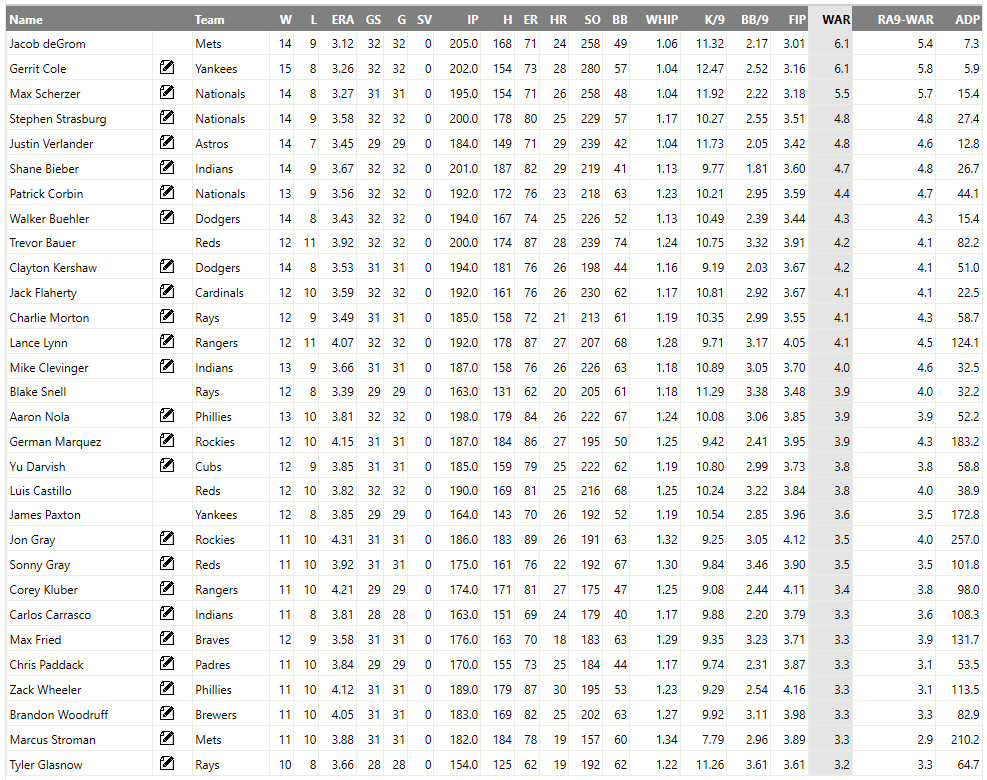
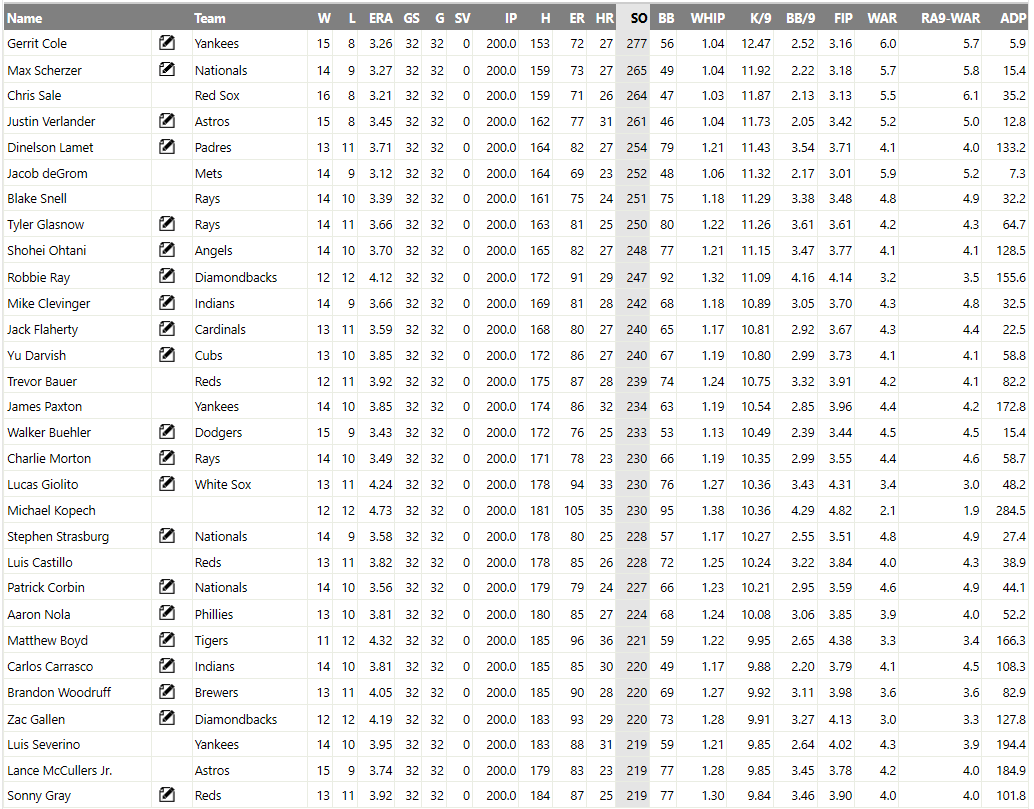
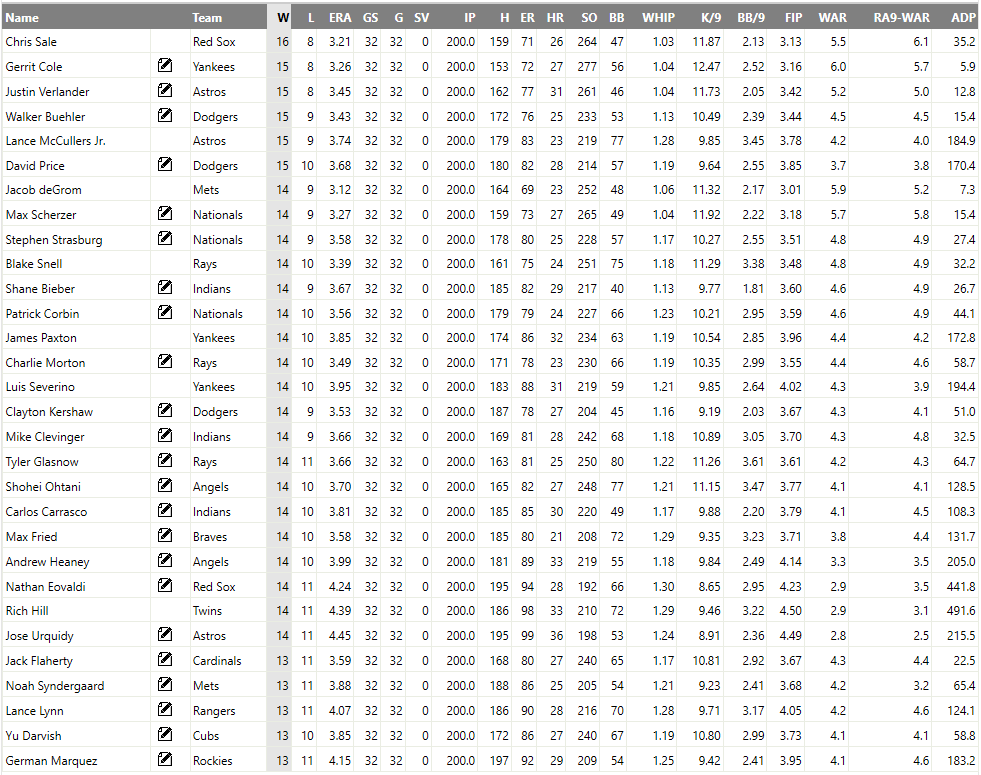
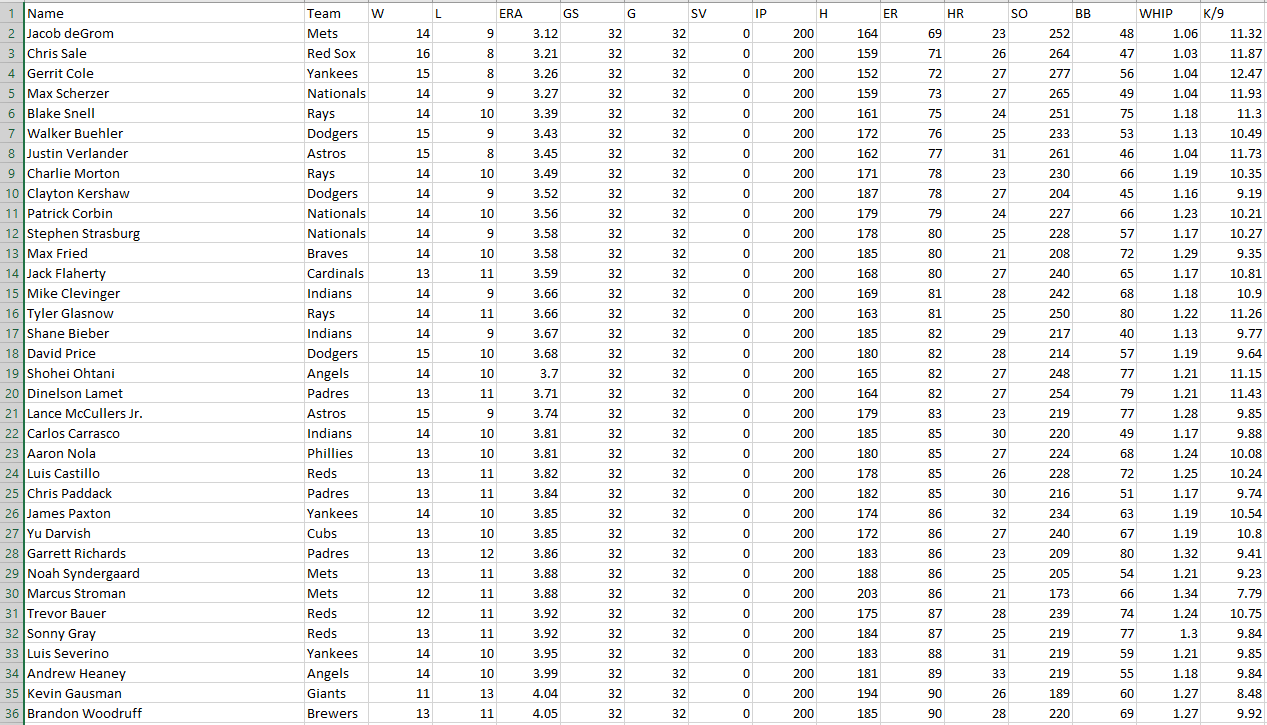
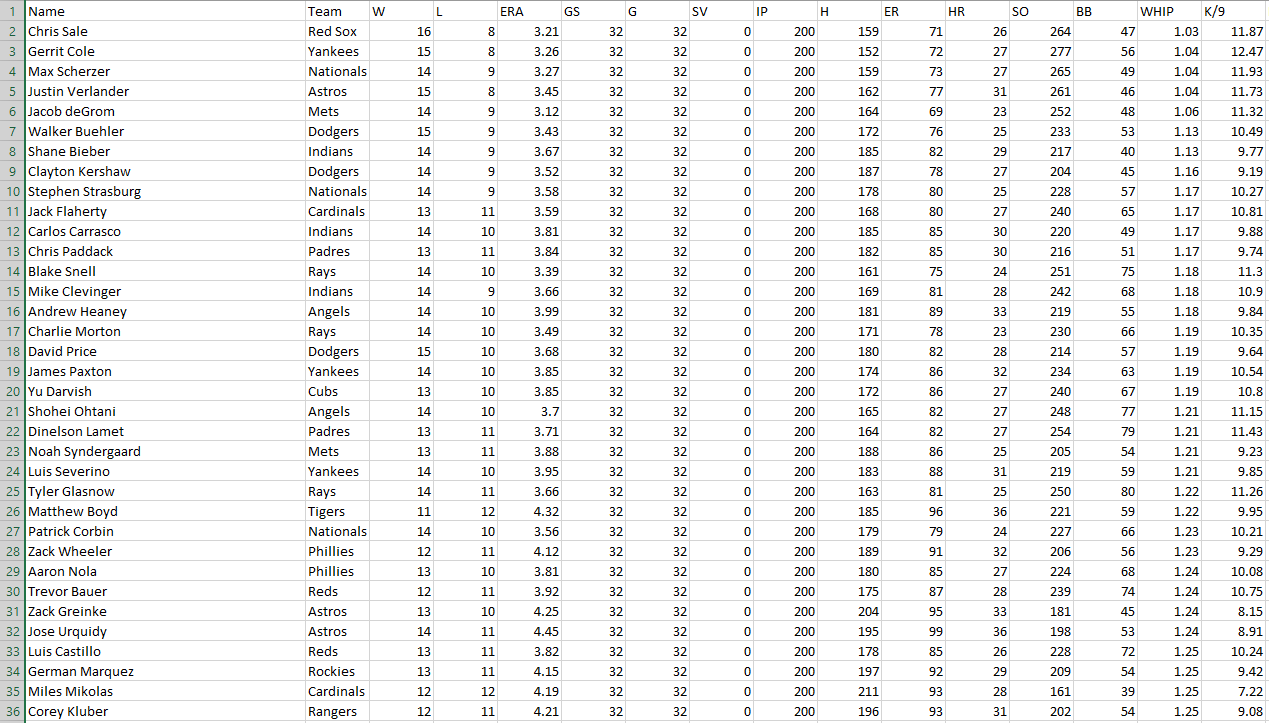
How do you rank Heaney, Marquez, Richards if COL does not play at home this year? (QS league)